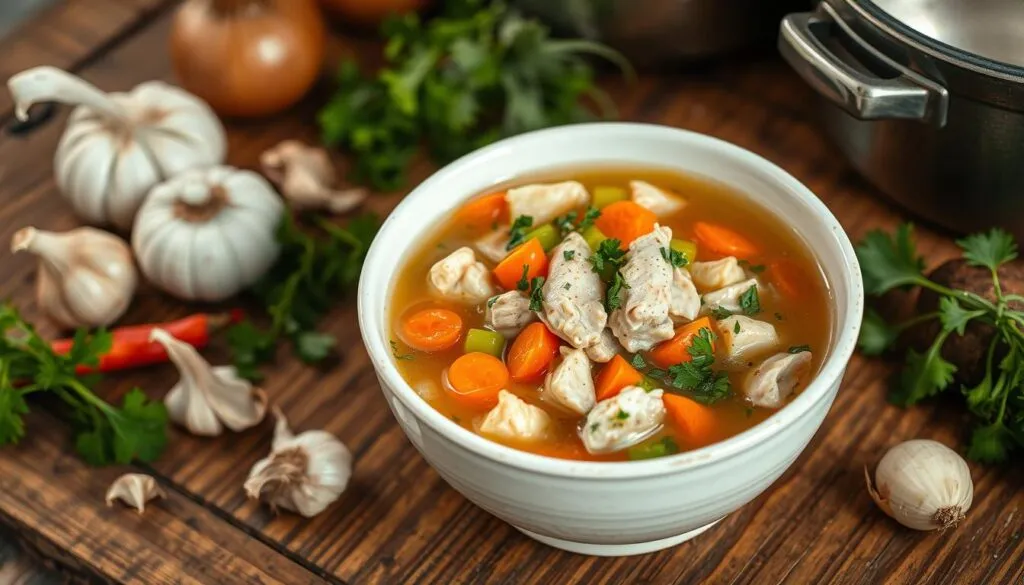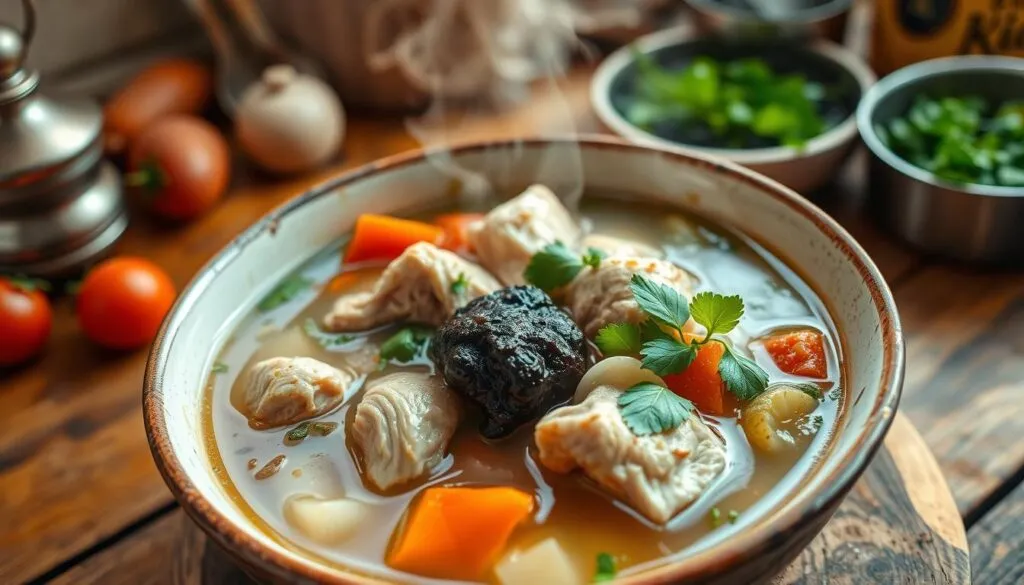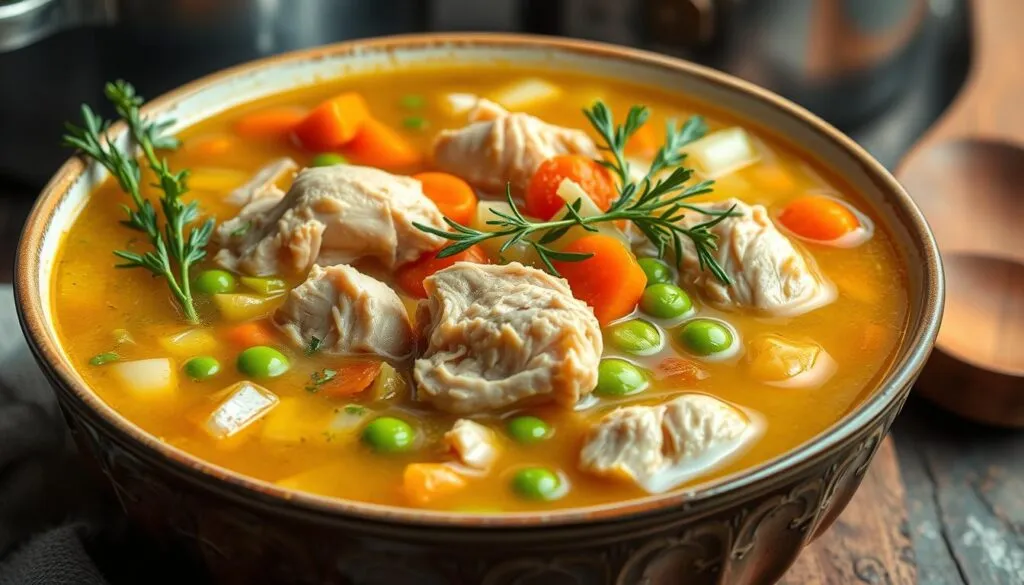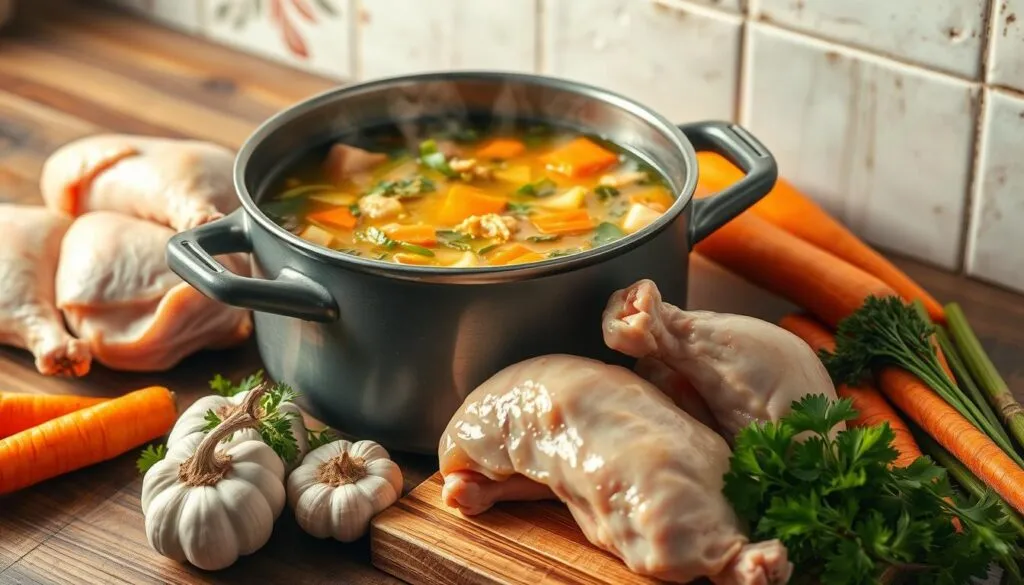Choosing the right chicken is key for a tasty chicken soup. You might wonder what kind of chicken is best for soup. The answer is in the cut. Chicken soup is a beloved comfort food, and the right chicken can elevate it.
Most chicken soup recipes use dark meat, like thighs and legs. This shows dark meat is a favorite choice.
Cooking raw chicken in soup takes about 30-45 minutes. The best broth simmering time is also around 30-45 minutes. To make the perfect chicken soup, you need to pick the right chicken. We’ll look at chicken thighs, whole chicken, and other cuts. This will help you find the perfect chicken for your next soup.
Understanding Why Chicken Choice Matters for Soup
The type of chicken you choose can really change how your chicken soup tastes and feels. A good chicken stock or broth is key to a delicious soup. The chicken you pick can make a big difference.
Chicken thighs are popular for soup because they stay juicy and flavorful. They stay moist even after cooking for a long time. Chicken breasts can dry out, but thighs stay juicy.
When you cook chicken thighs, they release collagen into the broth. This makes the soup rich and silky. Chicken legs and wings also add flavor and richness to the broth because of their fat content.
The Science Behind Flavor Development
Understanding how chicken affects the broth is important for a great soup. Chicken thighs have a lot of collagen, which makes the soup thick and rich. Chicken wings, with their fat, add flavor and richness to the broth.
How Different Cuts Affect Broth Quality
Choosing the right chicken can really improve your broth. Here are some things to think about:
- Chicken thighs: high in collagen, tender and juicy
- Chicken wings: high in fat, adds flavor and richness
- Chicken breasts: low in fat, can dry out if overcooked
Nutritional Considerations
Homemade chicken soup can be more nutritious than store-bought or canned soups. Cooking a whole chicken for a few hours makes the meat tender and the broth rich. Adding fresh veggies like carrots, onions, celery, and garlic boosts flavor and nutrition.
| Chicken Cut | Collagen Content | Fat Content |
|---|---|---|
| Chicken Thighs | High | Medium |
| Chicken Wings | Medium | High |
| Chicken Breasts | Low | Low |
The Classic Choice: Whole Chicken Benefits
Using a whole chicken for homemade chicken soup is a smart choice. It’s simple to prepare and makes a flavorful broth. The bones and meat add depth to the soup, making it a tasty and healthy option.
Whole chicken is packed with collagen, gelatin, and minerals. It also has more beneficial fats than processed chicken. This makes it perfect for those who want a healthy, organic soup.
Here are some key benefits of using a whole chicken for soup:
- Easy to prepare
- More flavorful broth
- Richer source of collagen, gelatin, and beneficial minerals
- Higher levels of beneficial saturated animal fats

Choosing a whole chicken for soup is a smart move. It’s easy to make and full of good nutrients. That’s why whole chicken is a top pick for homemade and organic chicken soups.
Dark Meat vs. White Meat for Soup Making

Choosing between dark meat and white meat for chicken soup involves several factors. Dark meat, like chicken thighs, is known for its rich flavor and tender texture. This makes it a great pick for a hearty chicken soup. White meat, such as chicken breasts, offers a leaner option for a delicious soup.
The best chicken for soup depends on the flavor and texture you want. Using both dark and white meat can add complexity to your chicken broth.
Benefits of Dark Meat
Dark meat has a lot of connective tissue. This tissue breaks down during cooking, making the broth rich and silky. It’s perfect for soups and stews. Dark meat also has a deeper, more intense flavor than white meat.
When to Use White Meat
White meat is leaner and has a milder flavor than dark meat. It’s great for a lighter, more delicate soup. It’s also lower in fat and calories, making it a good choice for those watching their diet.
Combining Both for Optimal Results
Using both dark and white meat can make a balanced and flavorful chicken soup. This way, you get the rich flavor of dark meat and the leaner aspect of white meat. Mixing chicken thighs and breasts can result in a delicious soup for any occasion.
Here’s a rough guide to get you started:
| Meat Type | Flavor Profile | Texture |
|---|---|---|
| Dark Meat | Rich, intense | Tender, silky |
| White Meat | Light, delicate | Lean, firm |
| Combination | Balanced, complex | Varied, interesting |
The choice between dark meat and white meat for chicken soup depends on your preference. Knowing the benefits and drawbacks of each helps you make a choice. This way, you can create a delicious, satisfying soup that suits your taste and needs.
What Kind of Chicken is Best for Soup: A Complete Analysis
Choosing the right chicken is key to a delicious and healthy chicken soup. Whether you want a comforting or lean meal, picking the right chicken is essential. We’ll look at the best chicken for soup, focusing on flavor, nutrition, and ease of use.

A great chicken soup starts with the right chicken. Older chickens, like old hens, have more flavor and nutrients. Their age also affects the soup’s taste and health benefits, making them a top choice.
When picking a chicken for soup, consider these factors:
- Age: Older chickens have richer flavors.
- Breed: Some breeds, like Thai native chickens, are packed with tasty amino acids.
- Cut: Chicken breast and thighs are common, but wings and legs work well too.
By choosing the right chicken, you can make a tasty and healthy soup. Whether you’re searching for the best chicken for soup or a simple recipe, experimenting is the way to go.
Bone-In vs. Boneless Chicken Options
Choosing between bone-in and boneless chicken can change your homemade chicken soup’s taste and texture. You might wonder which is better for a rich chicken stock or broth. Let’s look at the benefits of each.
Bone-in chicken, like chicken thighs with bones, makes your stock richer and more flavorful. This is because the bones release collagen and fat. Boneless chicken, while easier to cook, might not have the same depth of flavor.
The Role of Bones in Flavor Development
Bones in bone-in chicken are key for flavor. They release collagen and fat, making the stock more savory. This is vital for homemade chicken soup. Boneless chicken might need extra ingredients for flavor.
Cooking Time Differences
Cooking times differ between bone-in and boneless chicken. Bone-in cuts, like thighs and drumsticks, cook longer but are more tender. This longer cooking time is great for developing a deeper flavor in chicken stock.
In conclusion, your choice between bone-in and boneless chicken depends on your preference and the dish you’re making. Bone-in chicken is better for a rich, flavorful soup. But boneless chicken is quicker and more convenient. The secret to a great chicken stock or broth is using quality ingredients and slow, careful cooking, whether you choose bone-in or boneless.
Best Chicken Cuts for Quick Weeknight Soups
Choosing the right chicken cut is key for a quick, tasty soup on a weeknight. Boneless, skinless chicken thighs or breasts work great for chicken soup recipes. They’re easy to cook and add a tender, flavorful base to your soup.
A slow cooker chicken soup is perfect for a weeknight meal. It lets you cook chicken and veggies while you’re busy. Just add your ingredients, set the timer, and come home to a ready-to-eat meal. For a quicker soup, try a pressure cooker. It makes a hearty, flavorful chicken soup in under 40 minutes.
Here are some tips for a quick, delicious chicken soup:
- Use pre-cut veggies like carrots and celery to save prep time.
- Choose low-sodium chicken broth to lower the soup’s sodium.
- Add fresh herbs like thyme or parsley for a burst of flavor.
Follow these tips and use the right chicken cut for a tasty best chicken for soup recipe. Whether you use a slow cooker or a pressure cooker, you’ll have a comforting bowl of chicken soup ready in no time.
Organic and Free-Range Chicken Considerations
Choosing chicken for your soup can be a big decision. Organic and free-range chicken offer health benefits and better animal treatment. But, they might cost more than regular chicken.
In the U.S., over 8 billion chickens are raised for meat each year. Many live in factory farms with little space and light. Organic chickens, on the other hand, get to go outside and eat organic food. They don’t get antibiotics or GMOs.
Flavor Differences
Organic chicken often tastes richer and more complex. This is because of better feed and sustainable farming. These chickens may have more omega-3 fatty acids.
Cost vs. Benefit Analysis
Organic chicken might be pricier, but it’s good for you and the planet. Here are some reasons why:
- Higher welfare certifications like Animal Welfare Approved and Certified Humane show better treatment and farming.
- Organic chickens don’t get routine antibiotics, which helps fight antibiotic resistance.
- Organic farming is better for the environment because of sustainable practices and organic feed.
Choosing between organic and regular chicken depends on what matters most to you. If you want a sustainable and humane option, go for organic. Whether it’s for organic chicken soup or chicken poblano soup, the right chicken makes a big difference.
How to Prepare Your Chicken for Soup
Preparing your chicken right is key for a tasty chicken soup. You need to trim and clean it for safety and quality. You can choose between bone-in or boneless chicken, based on what you like.
First, rinse the chicken under cold water. Then, dry it with paper towels. Remove any extra fat or skin. Cut the chicken into smaller pieces if you need to. This makes it cook faster and more evenly.
Trimming and Cleaning Tips
- Rinse the chicken under cold water to remove any impurities.
- Pat the chicken dry with paper towels to prevent moisture from interfering with the cooking process.
- Remove any excess fat or skin to promote even cooking and reduce grease in the soup.
Optimal Cutting Techniques
Cut the chicken into smaller pieces, like bite-sized chunks or strips. This helps it cook quickly and evenly. It’s important for a homemade chicken soup to have tender and flavorful chicken.
Storage Recommendations
After preparing your chicken, store it in an airtight container in the fridge. It stays fresh for a while. You can also freeze it for up to 3 months. This makes it easy to have homemade chicken soup ready when you need it.
| Storage Method | Duration |
|---|---|
| Refrigerator | 4-5 days |
| Freezer | Up to 3 months |
Common Mistakes to Avoid When Selecting Chicken for Soup
Choosing the right chicken is key for a tasty chicken soup. Many people make mistakes that affect the soup’s flavor. A good chicken for soup has the right mix of meat and bones for a rich broth.
Common errors include picking the wrong chicken cut, overcooking, and not enough bones. These can lead to tough chicken and a weak broth. Here are some tips to avoid these mistakes:
- Choose a cut with a good meat-to-bone ratio, like a whole chicken or thighs.
- Don’t overcook the chicken to keep it juicy and tender.
- Use plenty of bones, like chicken feet or neck bones, for a flavorful broth.
By avoiding these mistakes, you can make a delicious chicken soup. Use high-quality chicken and prepare it well for the best results. Whether it’s a simple chicken noodle soup or a complex broth, quality chicken and proper preparation are key.
| Chicken Cut | Meat-to-Bone Ratio | Flavor Profile |
|---|---|---|
| Whole Chicken | 1:1 | Rich and balanced |
| Chicken Thighs | 2:1 | Dark and savory |
| Chicken Breast | 3:1 | Light and lean |
Regional and Cultural Chicken Soup Variations
Chicken soup is loved all over the world. Different cultures and regions have their own ways of making it. From Asian-style cuts to Mediterranean favorites, each place adds its own twist.
Local ingredients and cooking methods shape chicken soup recipes. In Latin America, it’s often made with rice, beans, and veggies. In Asia, it might include noodles, ginger, and soy sauce. Trying out these variations can lead to exciting new flavors and ingredients.
Exploring Global Chicken Soup Recipes
Here are some examples of regional and cultural chicken soup variations:
- Asian-style chicken soup cuts, such as wonton soup or ramen
- Mediterranean choices, such as Greek chicken soup with lemon and egg
- Latin American preferences, such as Mexican chicken soup with tortilla chips and avocado
These ideas can help you make your own special chicken soup. Use local ingredients and cooking methods for a delicious meal.
Regional Ingredients and Cooking Methods
Ingredients and cooking methods from different regions change chicken soup’s taste and texture. In Africa, peanuts and spices are common. In other places, coconut milk and lemongrass are used. Exploring these can add new flavors to your soup.
| Region | Ingredients | Cooking Method |
|---|---|---|
| Asia | Noodles, ginger, soy sauce | Steaming or stir-frying |
| Mediterranean | Lemon, egg, olive oil | Boiling or simmering |
| Latin America | Rice, beans, vegetables | Boiling or sautéing |
By trying out these variations, you can make a chicken soup that’s truly yours. It will show off your taste and cultural background.
Special Considerations for Slow Cooker and Pressure Cooker Soups
When making slow cooker chicken soup or chicken poblano soup, it’s key to think about each cooking method’s unique traits. Slow cookers take 6 to 8 hours on low or 3 to 4 hours on high. This long time breaks down collagen, making the meat tender. Pressure cookers, on the other hand, cook up to 8 times faster than slow cookers. They keep more nutrients in the food.
Slow cookers have some great benefits:
- They use 30% less energy than ovens.
- They make meal prep easy, letting you just set it and forget it.
- They enhance flavors because of the longer cooking time.
Pressure cookers, like the Instant Pot, are perfect for quick meals. They can cook frozen chicken in just 30 minutes, making a rich broth. Whether you like slow cooker chicken soup or chicken poblano soup, both ways can make tasty, healthy meals.
To make the most of your slow cooker or pressure cooker, follow these tips:
- Choose the right cut of meat, like chicken thighs or beef chuck roast.
- Get your ingredients ready ahead of time, like chopping veggies and marinating meat.
- Try out different recipes and seasonings to find your favorite.
| Cooking Method | Cooking Time | Nutrient Retention |
|---|---|---|
| Slow Cooker | 6-8 hours | Lower |
| Pressure Cooker | 30 minutes | Higher |
Conclusion: Making the Right Chicken Choice for Your Soup
The type of chicken you pick is key to making the best homemade chicken soup. You can choose tender chicken thighs, a tasty whole chicken, or mix different cuts. Each choice adds something special to the broth and the soup itself.
Understanding how flavors develop, the nutritional value, and regional tastes helps you make the best choice. This knowledge lets you pick the right chicken for your next soup.
It’s all about finding what works best for you and your cooking style. Feel free to try out different cuts and methods to find the what kind of chicken is best for soup. With this guide, you’ll be ready to make a delicious, healthy chicken soup that everyone will love.
FAQ
What kind of chicken is best for soup?
Choosing the right chicken for soup is key. The best chicken depends on flavor, texture, and nutrition.
How do different cuts of chicken affect the flavor and quality of the broth?
Different chicken cuts have more or less collagen and fat. These elements affect the soup’s flavor and texture. Knowing this helps pick the best chicken for your soup.
What are the advantages of using a whole chicken for soup?
A whole chicken is a classic choice for soup. It’s easy to prepare and makes a flavorful broth with its bones and meat.
When should I use dark meat versus white meat for chicken soup?
Dark meat, like chicken thighs, has a rich flavor and tender texture. White meat, like breasts, is leaner and can be just as tasty. Your choice depends on what you prefer.
What are the best chicken cuts for quick weeknight soups?
For a quick soup, choose the right chicken cut. Some cuts cook faster, making a hearty soup in no time.
What are the differences between organic and free-range chicken for soup?
Organic chicken might be healthier and treated better. But it’s pricier than regular chicken. Think about flavor, health, and cost when deciding.
What are some common mistakes to avoid when selecting chicken for soup?
Wrong chicken cuts or overcooking can make soup tough and tasteless. Avoid these mistakes for a tasty soup.
How does the cooking method (slow cooker, pressure cooker) affect the chicken choice for soup?
Cooking methods like slow cookers or pressure cookers matter. They affect the best chicken cut and the soup’s flavor and texture.

